Insect & Disease Conditions Update
A printer-friendly version of this report will soon be available on-line from the Conditions Report Index. This is the last planned Conditions Report for
the season. We plan to provide an update
on spruce budworm and winter moth late this year or early next; and will
provide other updates as the need arises.
We’re pleased to let you know that the Annual Summary Report for 2016 is
now available on-line from the Conditions Reports index page. They will be printed in the coming weeks and if you have a paper subscription to the ASR you will receive a hard copy when it is ready (expected by the end of October).
 Emerald ash borer has not been found in Maine. Late last week the emerald ash borer state
quarantine in New Hampshire was expanded.
Three trap-recoveries of emerald ash borer in Strafford County led to
the expansion (the quarantine previously encompassed Belknap, Hillsborough,
Merrimack and Rockingham Counties). Single
beetles were recovered on each of three traps on the western border of the
county, abutting the existing quarantine area in Belknap county. Though this doesn’t represent a significant
expansion of the known distribution of the pest, it is a considerable increase
in the number of miles of Maine’s border abutting an emerald ash borer
quarantine. New Hampshire has developed
very clear guidance for movement of ash within their quarantine, which may buy
us some time on spread from the generally infested area in New Hampshire. Notably, emerald ash borer was confirmed in
Quebec City this summer as a result of routine surveys. Again, no emerald ash borer has been detected
in Maine to-date. Maine Forest Service Information
Sheet #28 is a resource on emerald ash borer for Maine Landowners. It is available on the Maine Forest Service
website for download, or hardcopy by request (find the links at the bottom of
the Maine Forest Service' information sheets page). Read more about the New Hampshire quarantine
at www.nhbugs.org.
|
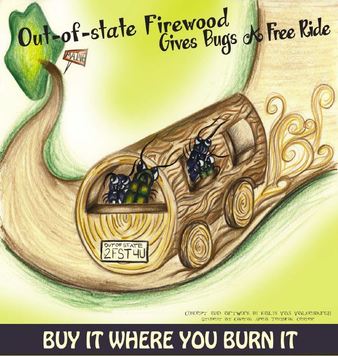 A recent incident brought home that focusing on a few invasive insects
can mislead the public about the danger to our forests from imported
firewood. A camp owner from out-of-state
brought seasoned oak firewood to his camp in rural Hancock county from a suburban
lot—the oak had fallen to “Superstorm Sandy.”
This individual was aware of the threats to our forest from Asian
longhorned beetle (ALB) and emerald ash borer (EAB), and expressed surprise
that we were concerned regarding the oak he had imported since it was not a
host for either.
We choose to highlight
ALB and EAB because we have evidence that public detections are important in
finding these insects in our forest and ornamental trees as quickly as
possible. There are dozens of other
threats to our forest that can move in or on firewood that the public will be
less likely to recognize. They range
from small bullet-shaped beetles that look nearly identical to our native bark
beetles, to large longhorned beetles which again, look like our own, to microscopic
fungi. The message, “use local firewood,”
is less complicated than enumerating hosts and descriptions of some key insects
of concern. However, we will continue to provide information about these few
“charismatic megafauna” with the hopes that you can help us find them, but with
the caveat that they are merely the tip of the iceberg when it comes to new
forest threats. Learn to identify those
insects, their signs and symptoms, but keep aware of changes in tree and forest
health, and report concerns beyond the most wanted list.
Please also help us spread the word to about firewood. Maybe you know
a neighbor who looks at a trip to camp as a frugal and environmentally
sensitive alternative to disposal of suburban tree waste. Consider helping your neighbor recognize the
costs associated with that activity. If
a neighborly chat is not enough to convince him or her to burn the wood
immediately, or there is too much wood for immediate consumption, you can
report your concerns to the MFS Forest Protection Division by phone at 1-800-750-9777
or online at http://www.maine.gov/dacf/mfs/rpt_concerns.html.
Because there is a quarantine on EAB in most states in the Eastern US,
transporting firewood into Maine from out-of-state is often not only a
violation of State rules, but also of Federal quarantine. Learn more at emeraldashborer.info and www.maine.gov/firewood.
|
Browntail moth (Euproctis
chrysorrhoea) – Remember to
inspect the tops of your apple and oak trees once the leaves have fallen. Look
for leaves TIGHTLY webbed together at the very tips of the branches – usually
near the top of the tree, but not always. These are the overwintering webs of
browntail caterpillars; inside you will find dozens to hundreds of tiny sleeping
caterpillars (less than ¼ inch long). You can find pictures of webs and information about what to do if you have them on our website, or call 287-2431 for additional information.
The Maine
Forest Service will be doing the annual browntail winter web survey in January
and February. This will give people a general idea of where the browntail is
being seen. It is not a comprehensive survey, we cover main roads and known
places of past infestations.
Populations
are expected to be lower than in 2017 but still will be affecting a lot of
people in a wide area, probably including new places not affected in past
years.

Datana spp.
(Datana drexelii, D. ministra) – Over the last month we have
received several e-mailed pictures of Datana
spp. From Ellsworth, we saw yellow-necked
caterpillar (D. ministra) on shad
bush and from Raymond and Portland, Drexel’s Datana (D. drexelii) on
blueberries. These caterpillars might go
unnoticed if it weren’t for their habit of feeding in large groups and
acceleration of feeding as they grow.
Photo: Drexel’s Datana on blueberry. Image: M. Yusem.
Noticeable defoliation tends to happen towards the tail-end of the
growing season and usually is not significant to the host plant’s health. Small plants, or those that were defoliated earlier
in the same growing season would be more sensitive. On small plants, such as blueberries, vigilant
monitoring beginning in July and early hand-picking is a good approach to
management. Egg masses are deposited on
the undersides of host leaves; larvae skeletonize the undersurface of the leaf during
the first instar. After their first molt, they will chew through both sides of
the leaf, starting at the leaf margin and progressing towards the central vein.
|
Eriophyid mites – Eriophyid mites are a diverse group of
mites that cause a wide array of reactions on their host plants. If you have noticed red felt patches (erinea)
on maple leaves, finger-like projections from cherry, Tilia spp., or maple leaves, or fist-shaped galls attached to ash
twigs, you have noticed signs of these mites.
Some species are well documented, others, obscure. Most are not of concern from a tree-health
standpoint. You probably would come to
that conclusion by thinking about how the species is affecting the host’s
ability to capture and use energy. For
the most part, trees with these mites can still photosynthesize at a reasonable
level and are not expending unusual amounts of energy due to the presence of
mites. Last month we received samples of
erinea on bur oak from southwestern Maine and photos of the same from
Caribou. This damage falls into the
obscure category, and may be caused by Eriophyes
triplacis. Control is not necessary.
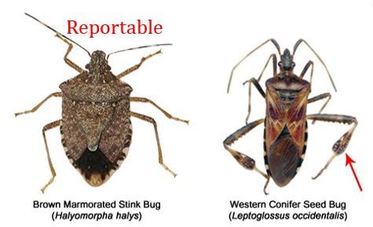 Nuisance insects of fall and winter – Although we are part of the Maine Forest Service and our focus is forest insects and diseases, that doesn’t stop questions coming in regarding the various insects that wind up in our homes looking for a safe place to overwinter. Chief offenders are western conifer seed bugs and Asian lady beetles. You can often see the invasion coming on fall days; dozens may congregate on the warm outside walls of your house. Although these insects can be startling and annoying it is the extremely rare one that does any damage to your home. The best defense is sometimes tolerance. You can also seal and screen any small openings as best you can and vacuum or otherwise capture and dispose of the insects that make it in. For further guidance on these house-guests, we recommend you consult the experts at The University of Maine Cooperative Extension Pest Management Office .
Image: Please report suspected sightings of the brown
marmorated stink bug (left). The
similar-looking western conifer seed bug (right) is not a reportable pest.
Notice on the seed bug the slenderer profile, the flattened hind-leg and
sharper head. Image: K. Coluzzi, MeDACF.
One thing we’d like you to report is any suspected co-habitation with brown marmorated stink bugs, especially in numbers. This potential crop-pest has been found in New Hampshire, and this year for the first time, control efforts have been recommended on an orchard crop in that state. This is the time of year we expect folks will notice them if they have a foothold in Maine. You can report your finds from the Stop BMSB website or locally to Maine Cooperative Extension or Maine DACF. Be prepared with photos or specimens for examination.
|
Southern pine beetle (Dendroctonus frontalis) – In recent years, the US-native bark beetle, Dendroctonus frontalis, or southern pine beetle, has been expanding
its range north from southern states and hosts. It has now been found as far
north as Massachusetts. This aggressive bark beetle has been observed attacking
pitch pine (Pinus rigida), eastern white pine (P. strobus) and Norway spruce (Picea abies) in the Northeast and killing trees on Long
Island, NY. For this reason, the Maine Forest Service is concerned about the southern
pine beetle continuing its northern expansion into Maine.
The southern pine beetle attacks
weakened trees. Like other bark beetles,
the first sign of their presence is pitch tubes on the trunk where the trees
are trying to drown the beetles in sap. The beetles overwinter in all life
stages and can have multiple generations in a year. Generally, infestations
start in a small area and then spread out as the population increases with many
beetles attacking the same tree to weaken its defenses.
The 2017 survey was conducted in
ten pine stands, nine pitch pine and one red/white pine. There were seven sites
in York County, two in Oxford County and one in Sagadahoc County. Surveys will
continue in future years to monitor for this insect.
No southern pine beetles have been
found in Maine to-date.
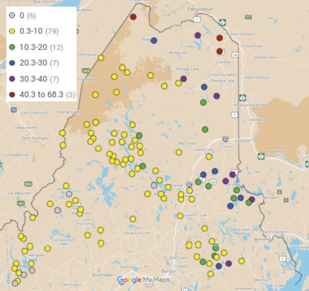 Spruce budworm (Choristoneura fumiferana) – The cooperative pheromone trap effort for spruce budworm is wrapping up for the year. As in the last several years, around 20 organizations participated in the program. Several cooperators have retrieved their traps and sent in their samples. Others will be collecting samples next month, concurrent with the Cooperative Forest Research Unit (CFRU)-led survey for overwintering larvae (L2 Survey). In addition, volunteers with the Healthy Forest Partnership Budworm Tracker Program have brought in their traps for the year and are sending in their catches. Together, the data from these sites should give us a decent picture of spruce budworm populations.
Image: MFS Cooperator SBW pheromone trap results as of 21 September, 2017; approximately 73% of sites have not been processed. Map Data: Google Maps
To date, about 27 percent of the MFS-Cooperator sites have been received and counted. Based on that sample, catches are on par with last year—down significantly from the summer of 2015. Across 114 sites, the average catch is about 9 moths per trap (average on the same sites was 6 in 2016). Catches range from 0 to 68.3 moths/trap. The highest catches are found in a 40-mile-wide band south of the northern boundary of the state. Sites in the eastern third of the state are trending towards higher catches than those in the western two thirds—this is apparent from Route 9, north to the St. John River.
We anticipate receiving moths from more than 300 additional sites, and the picture could change before the dust (composed of moth scales in this case) has settled from those samples.
Elsewhere, observers recorded very light and scattered defoliation on the New Brunswick side of the St. John River between Madawaska and St. Francis in ground plots. Aerial survey and additional ground plots picked up about 3,700 acres of light, scattered defoliation in the northern third of New Brunswick. Defoliation has intensified on the Quebec side of the border as well, with increases in area and intensity seen in the Bas-Saint-Laurent region, which lies closest to our northwestern border.
In addition to participating in the CFRU-led L2 surveys, MFS will conduct targeted surveys of host stands in the coming months in regions closest to the observed defoliation in Canada, and in response to high trap catches.
|
 Winter moth (Operophtera brumata) – When
you are out in the woods this fall and winter, keep an eye out for large
numbers of moths. If you are east of Rockland or in towns removed from the
coast, and seeing numbers of moths, we encourage you to collect and submit
samples to the lab (MFS, 168 SHS, Augusta ME 04333-0168). We know winter moth can be found
along the southern coast and would like to know if it has spread inland. Also,
we are looking for Bruce spanworm (Operophtera
bruceata) outbreaks. This insect is native,
closely related to the invasive winter moth and we would like to be able to
study what keeps it under control.
Image: Be on the lookout and report winter moth sightings. The
moths will fly in November and December.
East of Rockland and in from the coast, please collect and mail in
samples. Image: Maine Forest Service
|
Drought stress has impacted trees in the southern half of Maine for
much of this summer season, essentially a repeat of last year’s very dry months
of July and August. The drought has been especially tough on trees along the
coast and on the islands, leading to dieback and mortality. As water is
essential for all processes in trees, water deficit causes major problems and
represents a very significant stress.
This same stress in back-to-back growing seasons could potentially have
negative short- and long-term impacts on tree health. Reduced vigor due to drought
stress may lead to outbreaks of damaging forest pests, such as bark- and
wood-boring beetles. Some trees may
develop higher susceptibility to spider mite, aphid and scale infestation,
further reducing tree vigor.
Trees may show a variety of
symptoms following an extended period of drought stress, and the reaction can
be species-specific. Some deciduous trees may drop their leaves and enter dormancy
early, while coniferous trees may progressively drop their oldest needle
classes – this may be noticed as fall needle drop occurring at an exaggerated
level. Other general symptoms are wilting, marginal necrosis (dying tissue at
the leaf margins), tip dieback of needles and a significant slow-down of later-season
growth. Several tree species exhibit
early fall coloration, which is why areas here and there on the landscape in
Maine reached peak color very early this year.
While nothing can be done to
alleviate drought stress for forest trees, trees growing in municipal/horticultural
settings can be watered well into the fall to encourage regrowth of fine roots
that often die due to drying out during times of severe water-deficit. Looking forward, keep a close eye on trees next
season for early detection of fungal and/or insect attack in order to apply
rapid management for these, in this case, secondary tree pests.
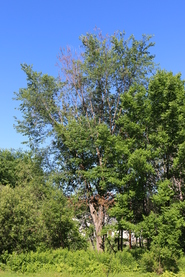 Dutch elm disease (DED) is a perennial issue and was evident throughout central and southern Maine as symptoms developed in mid-summer 2017. During a recent trip to northern Maine, DED was also noticed in a few locations. Overall, the level of disease is judged to be at a moderate level in younger elms in mixed forest and roadside stands. Landowner requests for assistance have been up slightly from previous years, but the anecdotal information from field staff and land managers has indicated that, from a statewide perspective, DED levels are about normal this year.
Image: An elm tree in Manchester, Maine infected with DED and
scheduled for removal this autumn. Maine Forest Service.
Occurrence of DED on the landscape tends to patchy. Some areas can develop high disease levels with large-scale mortality over a short time period, while some areas remain disease-free for an indeterminant amount of time. The scale of infected areas and rate of expansion vary depending on the living elm population and if any management practices are followed as elm trees die. If infected trees are cut down the year they show symptoms and burned or debarked or buried, the rate of spread is greatly reduced. Where infected trees are left standing, they will become infested with elm bark beetles. These beetles will become contaminated with spores of the DED fungus as they emerge in spring and infect nearby healthy elms. This year, the Maine Forest Service forest pathologist visited several areas with high levels of mortality, even of large, stately American elm trees that have survived the various past waves of DED. Losing these trees from our landscape is disheartening. Early detection and proper management are key to preserving Maine’s large elm trees for as long as possible.
The DED complex is expected to persist in the native range of American elm for years to come. This is due to the tendency of young elm trees to be resistant to the fungus. This resistance seems to be lost after the tree reaches seed-bearing age. Trees are often able to produce seeds for at least a few years before they become diseased, giving rise to a new cohort of elm trees. So, with the constant presence of the host, the disease and its bark beetle vectors, mortality of elm trees due to the Dutch elm disease complex is expected to continue where elm trees grow. While there are chemical injections that, when applied correctly, provide protection from DED infection, this is a long-term and expensive commitment usually reserved for the highest-value specimen trees.
|
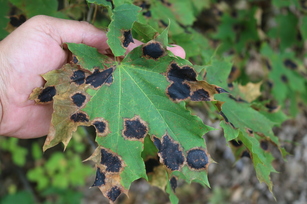 Tar spot of maple, caused by the native fungus, Rhytisma acerinum, is especially prevalent in several parts of Maine this year. R. acerinum especially affects the non-native Norway maples, including cultivars of Norway maple in horticultural settings, such as the burgundy-leaved Crimson King maple. There are three species of fungi in the genus Rhytisma that produce a tar spot symptom on our native maples, but these are encountered less frequently and cause minor damage.
Image: By mid- to late summer, black fungal spots develop, which
are the spore-producing structures of the fungus. Leaves with multiple
infections eventually turn brown, and drop prematurely from the tree. Maine Forest Service.
The fungi that cause tar spot survive the winter in fallen leaves and produce and disseminate spores during prolonged periods of wet weather in spring. This year, May and June were particularly wet in many parts of Maine, leading to high disease incidence and severity in late summer. Collecting and disposing leaves is the recommended management strategy. If composting the collected leaves on-site, the leaf piles should be covered with a layer of soil, a dense layer of grass clippings or other compost. This will prevent the fungus from dispersing spores to re-infect maples the following spring. Leaves can also be burned when and where this is permitted. While fungicides are available and effective, chemical management of tar spot is rarely required or practical.
In a forest environment tar spot diseases rarely reach high levels of severity, since severely affected leaves are prematurely shed by the tree, which can prevent complete development of spore-producing structures. Also, leaves dropped prematurely are largely covered up by layers of leaves of other forest trees during normal fall leaf drop, blocking spring spore dispersal.
The tar spot diseases primarily represent an aesthetic issue to ornamentals and have little detrimental effect on the long-term health of affected trees. Infected leaves retain most of their photosynthetic capabilities throughout most of the growing season and buds for next year’s growth are already set by the time the black spots form. Leaf drop is late enough in the season so that a re-foliation by the tree is not usually triggered. This means that the energy reserves already stored will be preserved and sufficient to compensate for any damage, allowing the tree to develop normally next spring.
|
 Tip dieback of red oaks (Botryosphaeria sp.) – Branch tip dieback of red oaks has been
observed in several locations in Maine in recent weeks. The typically observed
symptoms include a random pattern of dead branch tips with wilted orange to
brown leaves. This can be mistaken for oak twig pruner damage, however tips of
fine branches are not hollowed out, but are blackened and appear scorched.
Oblong cankers may be present on symptomatic twigs further back on the blighted
twig. This condition is often worse on trees that have experienced some kind of
stress, weakening trees enough for the fungus to cause symptoms.
Image: Typical tip dieback symptoms commonly seen in oaks across
Maine (arrow). Maine Forest Service.
|
Office hours are 7:30 a.m. to 4:00 p.m., Monday through Friday, except
for holidays. If you plan to visit
either office, you may wish to call ahead just to make sure someone will be present
to meet with you. (207) 287-2431 (Augusta) and 827-1813 (Old Town)
Browntail Moth Forums
-
November 9 Falmouth, 6 pm, location to be announced
-
November
30 Camden Public Library, 7 pm
Invasive Forest Pest Displays, Maine
Soil & Water Conservation Districts, under a grant from the Invasive Forest
Pest Outreach Project of the Department of Agriculture, Conservation and
Forestry, will have invasive forest pest displays at the following upcoming events:
-
October
14 A Day in the Woods at Hidden Valley Nature Center in Jefferson
(Lincoln County)
-
November
11 Craig Brook Fish Hatchery Spawning Festival in East Orland
(Hancock County); display & mini-presentations throughout the day
-
November 11
& 12 Maine Harvest Festival in Bangor (Penobscot County)
Conditions Report No. 5, 2017
On-line: http://maine.gov/dacf/mfs/publications/condition_reports.html
Department of
Agriculture Conservation & Forestry
Maine Forest Service - Forest Health and Monitoring
Contributors: Aaron Bergdahl, Charlene Donahue, Allison Kanoti
|